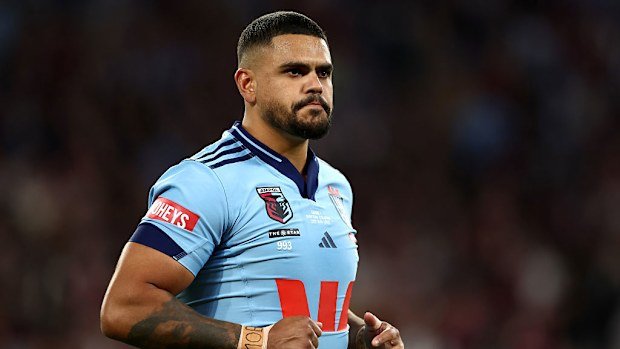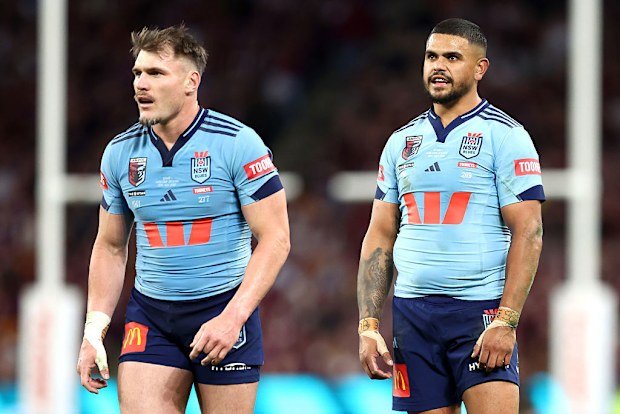A subtle adjustment in the Blues’ attacking approach might be the key to unsettling Queensland in the State of Origin series finale, as per Andrew Johns’ insights.
Despite five players entering the camp facing injury and illness issues, there have been no alterations to the starting line-up for the home side.
In game two, the Blues managed to score more tries than the Maroons but ultimately fell short due to some wayward goal kicking.
However, Johns asserts that NSW has yet to fully capitalise on its attacking potential and insists that the game strategy should prioritise delivering early ball to the flanks come Wednesday night.
“We need to leverage our strengths,” he remarked on Wide World of Sports’ Immortal Behaviour.
“If you analyse the team, strengths abound across the field.

Latrell Mitchell of the NSW Blues runs out in game one of the 2025 State of Origin series. Getty
“Consider Angus Crichton and Latrell Mitchell on the left, with Liam Martin and Stephen Crichton on the right. We must play to their strengths, ensuring they receive quality ball—understanding not just where, but also when to deliver it.”
“In Perth, under tough conditions during game two, Latrell assisted Brian To’o with three tries purely through his skillset; however, the defence met him too quickly. If we can provide him with more opportunities, he becomes a real threat.”
Catch the 2025 State of Origin series exclusively live and free on Nine and 9Now.
Mitchell’s limited ball handling during that match was acknowledged by coach Laurie Daley, who noted the Maroons’ defensive setup as an obstacle afflicting the halves in supplying the centre.
Johns believes that the success of the edges hinges on the performance of the middle forwards.
“To get him the ball against an unorganised defence, we need to focus on offloads,” Johns explained.
“How do offloads happen? Your halves must be up alongside the forwards, providing crucial support.
“Once offloads begin, direct them straight to Latrell or Critta on the flanks, as the defence will be uneven. If you give Latrell little openings, he can outpace a defender. One-on-one tackles won’t suffice.”
“In game one, we achieved 15 offloads, but in game two, we were limited to just five.”
“When attacking on halfway, the defence on the flanks tends to be less aggressive. Wingers can drop back, granting Latrell and Critta extra time.
“The halves must recognise that while it’s advantageous to engage defenders, the longer they linger close to the ruck, the less opportunity they afford the edge attack.”
“The true strength of this team resides on the flanks. I would love to see them utilise the ball more,” he elaborated.
“The spine needs to understand that they cannot depend on the forwards for a swift play of the ball and simply instruct, ‘go there’. They must be dynamic and engaged, creating one-on-one tackles, rapid play-the-balls, and offloads.
“If NSW executes this effectively, they’ll face Latrell not merely one-on-one, but one-on-two—and he has the ability to break through.”
“We witnessed Angus last year in Melbourne; no one could stop him. It’s similar with Critta, and let’s not forget the relentless Liam Martin.”

Angus Crichton and Latrell Mitchell in action during game one of the 2025 State of Origin series. Getty
However, for NSW to implement this strategy successfully, all players must be willing to step away from the systems they utilise at the club level.
“I’d urge them to advance, offer more support, and favour offloads,” Johns proposed.
“This can be challenging as many of these players adhere to their established systems. But when you have both speedsters and heavyweights out wide, you must capitalise on that.”
“The core of the team has been training together for five or six years; getting this right will create a really special squad.”
Compiled by SportArena.com.au.
Fanpage: SportArena.com.au.
LiveScore – Live Sports Results & Odds.




